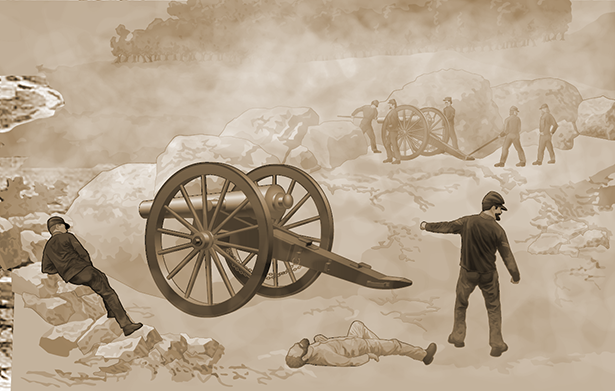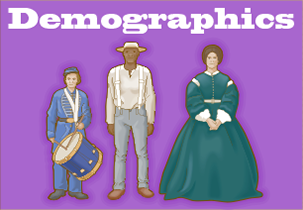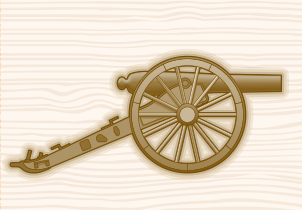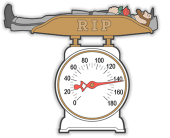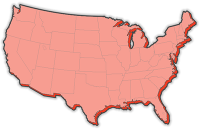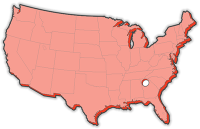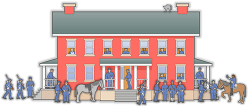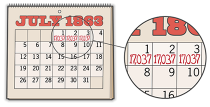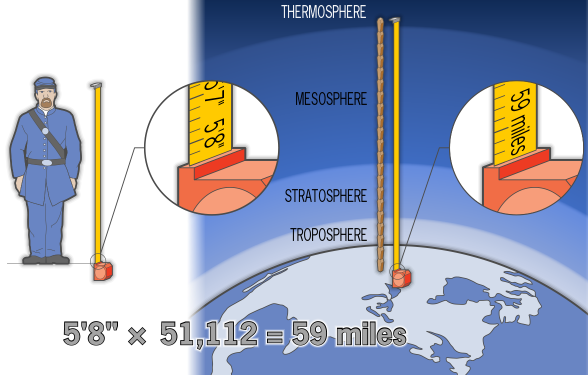
The average height of men in 1863 was 5 feet 8 inches (68 inches). if you laid the dead in a line (head to toe), the line would stretch 3,475,616 inches. That’s 289,635 feet or nearly 59 MILES! That distance would take you into earth’s thermosphere, which begins at about 56 miles up.
NEXT
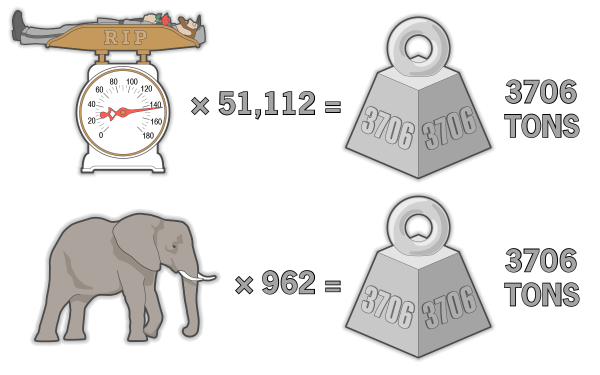
The average weight of a Union soldier was 145 pounds, so the total weight of the dead would be 7,411,240 pounds or 3706 TONS. An African elephant weighs about 7,700 pounds, so that’s about the same as 962 elephants.
Questions:
What else is about 59 miles?
How long would it take you to ride a bike
that far?
What else weighs about 3706 tons?
How do people move something that heavy?
What does this make you think about the numbers of casualties at Gettysburg?
START
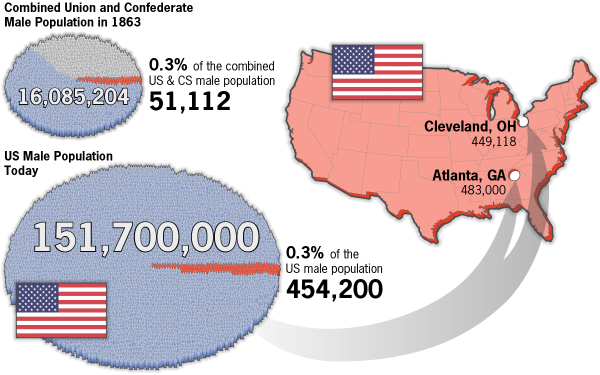
If you assume that approximately half of the population of the US in 1863 was men, then there were 16,085,204 men, and the casualties at Gettysburg represent 0.3% of all men in the US at the time. Looking at the Civil War as a whole, the country lost 4% of the men in the country.
Today we have 151.7 million men in the US. If we lost the same percentage of men as were lost in the Battle of Gettysburg, it would be like losing 454,200 men at one battle. By comparison, the current population of Atlanta, GA is 483,000. Cleveland, OH is 449,188.
Question:
During other wars, the loss of many men has changed the roles for people left behind. Can you find examples of how losing so many men can change employment, families, and even where and how people live?

The native population of Gettysburg was 2400 in 1863. We know that about 160,000 soldiers participated in the Battle of Gettysburg, which is more than 66 times the population of the town where the battle took place.
Given that today, the populations of Chattanooga, TN, Tallahassee, FL, Springfield, MO, and Ft. Lauderdale, FL are each approximately the same as the number of soldiers who fought in the battle of Gettysburg.
NEXT

Questions:
What would it have been like to have that number of men march into your town?
Where would you put them all?
What would happen to traffic?
What kind of resources does your town/city have for the arrival of large groups of outsiders?
Who is in charge of planning in your town?
Has your town ever handled a large, unexpected influx of people?
Can you find examples in recent news of towns that had large numbers of outsiders arrive suddenly because of a media event or something else?
How did they handle it?
START
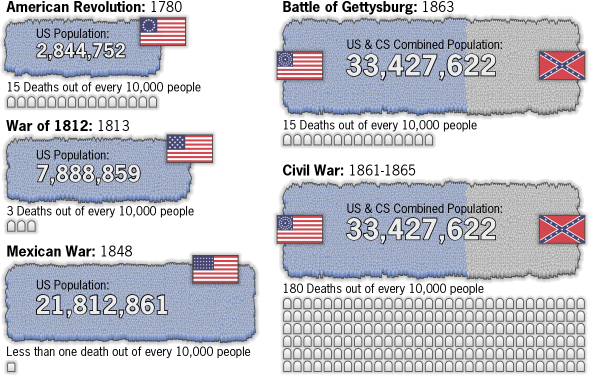
If you view the casualties as a proportion of the total US population, 0.15% of the US population died at the Battle of Gettysburg:
In 1863, the US population was 33,427,622. 51,112 casualties represent 0.15% of total population.
If you look at the Civil War as a whole, the casualties were 1.8% of the population.
In 1780 (Revolutionary War), US population was 2,844,752 and the deaths from that war represent 0.15% of population.
In 1813 (War of 1812), US population was 7,888,859, and the deaths from that war represent 0.03%of the population.
In 1848 (Mexican War), US population was 21,812,861, and the deaths from that war represent 0.008% of population.
NEXT

Questions:
Find out how many people live in your town/city. How many would .15% of the population be (equivalent to the proportion who died in at Gettysburg)?
What about 1.8% (equivalent to the proportion who died in the Civil War). How many families would be touched by these deaths?
What kind of impact might it have on local business, families, schools, and the economy in general?
START
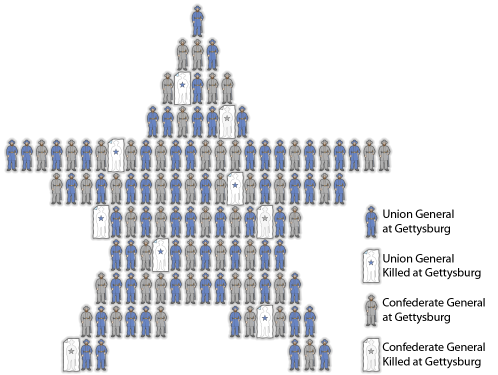
Of the 120 generals who participated in the Battle of Gettysburg, 9 were killed at the Battle, the highest number of generals lost in one battle during the Civil War.
Question:
If the same proportion of NFL head coaches (the leaders and commanders of the teams) suddenly were taken away, what might happen to the followers (players)?
How would they be replaced, and what do you think would happen to team wins/losses in the meantime?
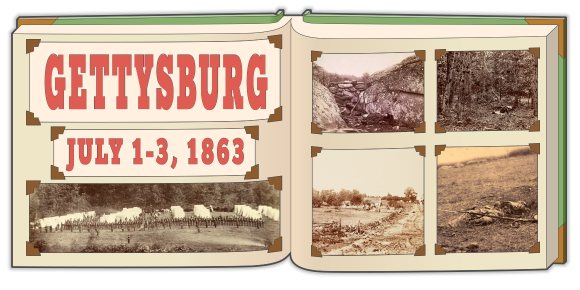
More than one third of all the photographs of dead soldiers taken during the Civil War were of those who died at Gettysburg.
Questions:
Why were photographs of Gettysburg especially powerful to those who saw them?
What do you know about photography then?
Why did people take photographs of individuals?
How was it different from the way we use today’s smart phone cameras?
How often do you see a photograph of the scene of a major news event?
How quickly can you find one?
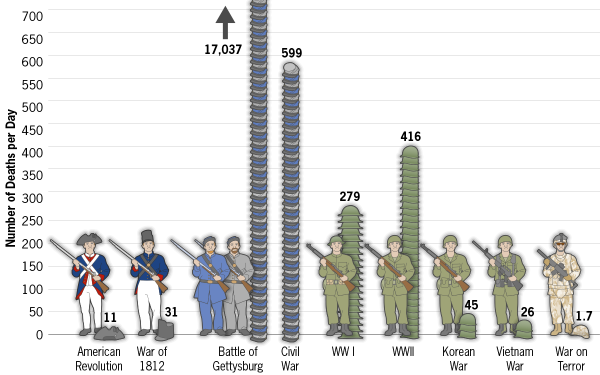
The Civil War had the highest number of casualties PER DAY of any US war in history (599 per day). The Battle of Gettysburg lasted 3 days with an average of 17,037 casualties PER DAY!
In comparison to other US wars:
• WWII: 416 deaths per day
• WWI: 279 deaths per day
• Vietnam: 26 deaths per day
• Korean War: 45 deaths per day
• Revolutionary War: 11 deaths per day
• War of 1812: 31 deaths per day
• War on Terror (Iraq/Afghanistan): 1.7 deaths per day
NEXT

Questions:
What other dangers or factors cause between 90 and 599 deaths per day in the U.S.?
Are there ways these could be prevented? What about diseases?
START
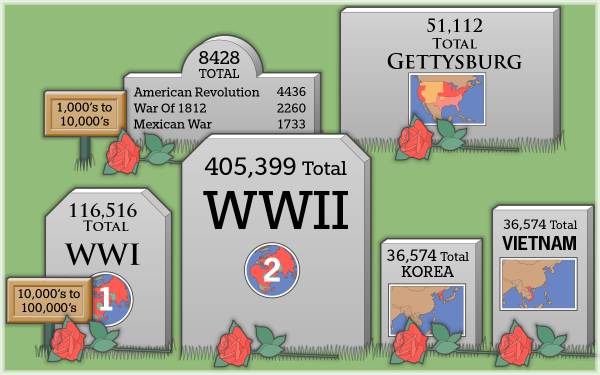
According to the U.S. Army’s official calculations, there were 51,112 casualties as a result of the Battle of Gettysburg. This includes those who died later from wounds received in the battle, those never found, etc. (See Clean Up for more about how people handled all the dead.)
This is 6 times more than had died in all previous US wars combined:
Revolutionary War: 4435 deaths
War of 1812: 2260 deaths
Mexican War: 1733 deaths
Total: 8428 deaths
Comparison with other major US wars:
WWI: 116,516 deaths
WWII: 405,399 deaths
Korean Conflict: 36,574 deaths
Vietnam: 58,209 deaths
NEXT

Questions:
Which war(s) have you heard about the most?
What events or mentions make them more notable?
Do you know about them in proportion to the number who died, or does something else make a certain war more worthy of attention?
START
Close x |
TeachersFirst.com ⋅ Thinking Teachers Teaching Thinkers® ⋅ Copyright © 1998-2024 by The Source for Learning, Inc. All rights reserved.


